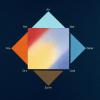Alchemy, the Four Elements, and the Tria Prima
Commentary
Image 1. Alchemist adopted the theory of the four elements canonized by Aristotle. But they claimed to possess a deeper philosophical knowledge than that ordinarily available to Scholastic scholars, which had been gained by observing and experimenting with the elements in the laboratory. This pursuit of new knowledge, founded on direct observation of and experimental intervention in the physical world, is made explicit in the motto on the long banner, 'Let us go and seek the nature of the four elements'.
These experimental investigations eventually gave rise to the positing of 'tria prima' ('three primes') which coexisted and competed with the Aristotelian four elements in Paracelsian alchemical theory and practice. The pioneering medieval Arab alchemist, Jābir ibn Hayyān or Geber maintained the four classical elements of air, earth, fire, and water but added to them two new philosophical elements: sulphur and mercury. To these, Paracelsus added a third principle: sulphur was the combustible element, mercury the fluid and changeable element, and salt the solit, permanent element. He illustrated this theory by burning a piece of wood: the fire was the work of sulphur, smoke of mercury, and the residual ash of salt. HUman beings were organised in analogous fashion: salt corresponded to the body, mercury to the spirit (the source of imagination, moral judgment, and the higher mental faculties), and sulphur to the soul (the seat of emotions and desires).
Image 2. This second image attempts to reconcile the four elements and the tria prima graphically, through the kind of imagery fundamental to alchemical thought and practice. The three vertices of the triangle represent the tria prima: soul (anima), spirit (spiritus) and body (corpus). The four corners of the square contain symbols of fire, air, water, and earth. The seven points of the star contain the symbols of the seven planets: 1. Saturn, 2. Jupiter, 3. Mars, 4. Sun, 5. Venus, 6. Mercury, 7. Moon

